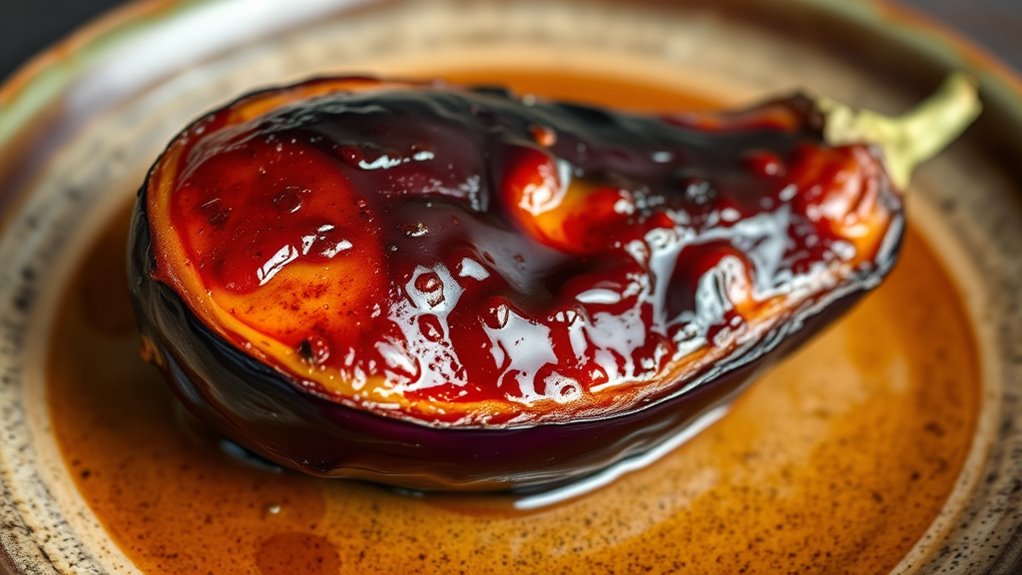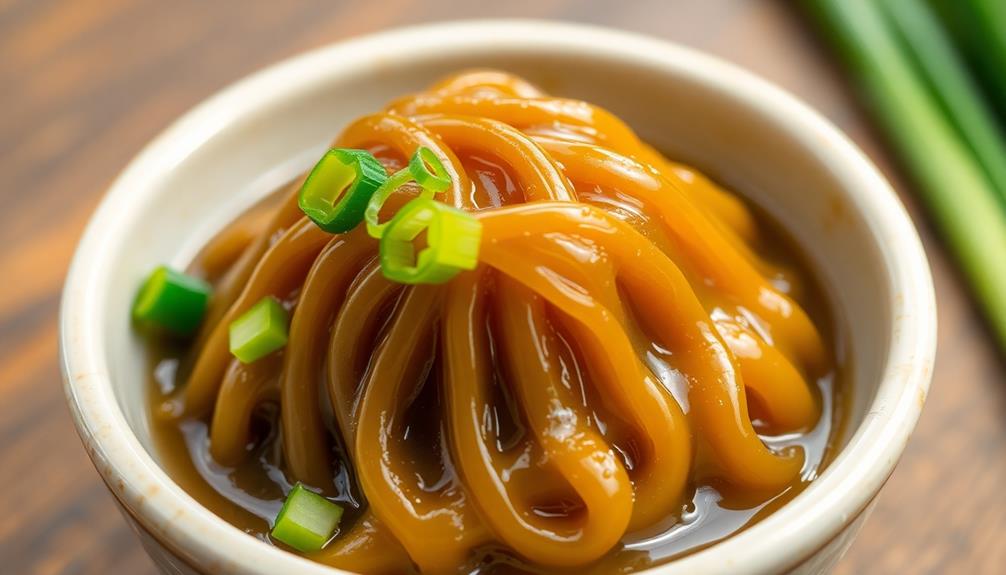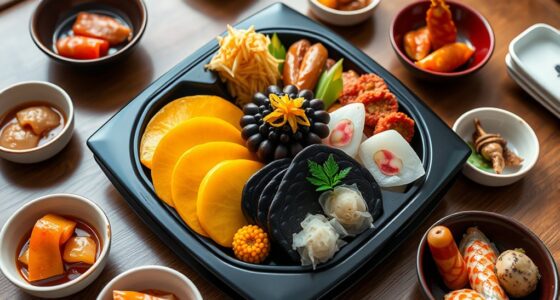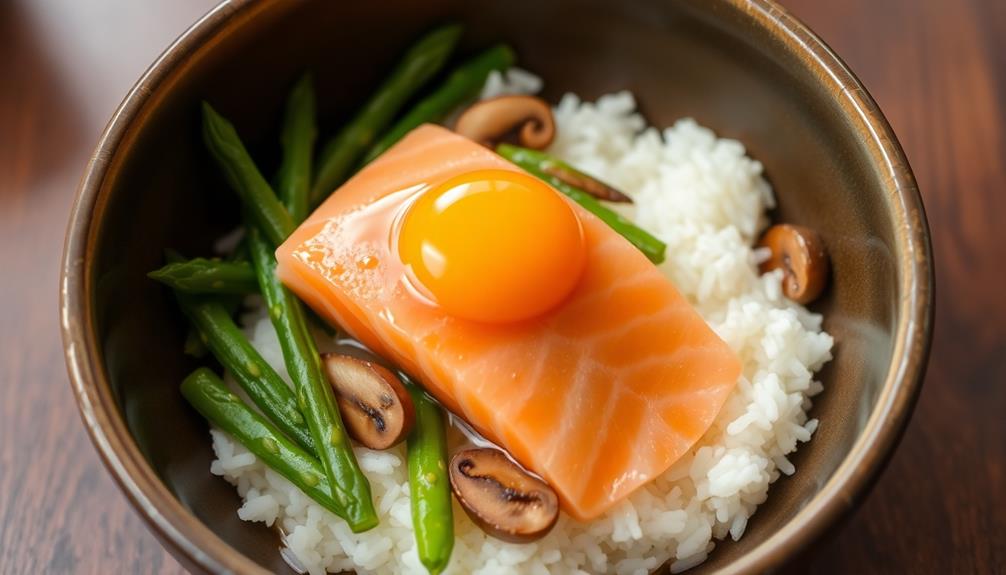To achieve the Maillard-savory punch in miso-glazed eggplant, you should focus on broiling or grilling to foster caramelization and deepen flavor. Adjust the glaze with ingredients like ginger, garlic, or a splash of rice vinegar for extra complexity. The natural sweetness of ripe summer eggplants or the milder flavor of winter varieties can influence your preparation. Keep exploring, and you’ll discover more ways to balance umami and caramelization for a truly irresistible dish.
Key Takeaways
- The miso glaze provides umami richness, while broiling or grilling triggers the Maillard reaction for a savory caramelized crust.
- Seasonal eggplant variations influence flavor; summer eggplants add sweetness, winter varieties offer milder taste, enhancing the Maillard effect.
- Proper cooking techniques, like broiling, intensify caramelization, deepening flavor and creating a savory, crispy exterior.
- Complementary ingredients such as sesame oil, herbs, and acidity balance the dish’s umami and enhance the Maillard-savored crust.
- Adjusting preparation and seasonings allows customization, highlighting the Maillard reaction’s savory complexity year-round.

If you’re looking for a flavorful and easy-to-make vegetable dish, miso-glazed eggplant is an excellent choice. Its rich umami flavor and tender texture make it a standout in any meal. One of the best aspects of this dish is its versatility across seasonal variations. During summer, ripe eggplants are at their peak, offering a slightly sweeter and more delicate flavor, which pairs beautifully with the salty, savory miso glaze. In contrast, winter eggplants tend to be firmer and milder, allowing the glaze to shine without overpowering the vegetable’s natural taste. This adaptability means you can enjoy miso-glazed eggplant year-round, adjusting the preparation slightly to match the season’s produce and your flavor preferences.
When it comes to flavor pairings, miso-glazed eggplant lends itself to a variety of complementary ingredients. The umami-rich miso works well with fresh herbs like cilantro, basil, or scallions, adding brightness and depth. A drizzle of sesame oil or a sprinkle of toasted sesame seeds enhances the nutty notes, creating a harmonious balance. For a touch of acidity, consider adding a splash of rice vinegar or a squeeze of lemon, which cuts through the richness of the glaze and adds an invigorating contrast. You can also incorporate elements like ginger or garlic into the glaze itself for an extra layer of warmth and complexity. Additionally, the Maillard reaction that occurs during broiling or grilling enhances the savory flavor and creates a delicious caramelized crust. Incorporating the seasonal produce can elevate the dish’s freshness and flavor profile, making it even more appealing. Moreover, understanding the natural flavors of the eggplant helps in customizing the dish to suit different tastes and cooking methods. A deeper understanding of cooking techniques like broiling and grilling can help you achieve the perfect caramelization and flavor depth.
The savory, umami profile of miso pairs beautifully with other ingredients commonly found in Asian cuisines. For example, serving the eggplant alongside steamed rice or noodles helps soak up the flavorful glaze and makes for a satisfying meal. It also pairs nicely with pickled vegetables or a simple cucumber salad, which provide a crisp, tart counterpoint to the soft, glazed eggplant. If you’re feeling adventurous, adding a hint of honey or maple syrup to the glaze can introduce a subtle sweetness that balances the saltiness and intensifies the Maillard reaction during broiling or grilling. This flavor harmony makes miso-glazed eggplant not just a side dish but a centerpiece that can elevate a variety of meals.
In essence, the beauty of miso-glazed eggplant lies in its adaptability—whether you’re adjusting for seasonal variations or experimenting with flavor pairings, it remains a savory, satisfying choice. Its combination of tender texture, umami depth, and customizable accompaniments ensures you’ll keep coming back to this dish, no matter the time of year.
Frequently Asked Questions
Can I Use Alternative Sweeteners Instead of Honey?
You can definitely use alternative sweeteners instead of honey in your recipe. Sugar substitutes like maple syrup or agave nectar work well, especially vegan sweeteners that provide similar sweetness and moisture. Just keep in mind that some substitutes may alter the flavor slightly. Adjust the amount to taste, and remember that natural sweeteners like coconut sugar can also be good options if you prefer less processed ingredients.
How Do I Prevent the Eggplant From Becoming Soggy?
To prevent your eggplant from becoming soggy, focus on maintaining a crisp texture. Start by properly draining excess moisture after slicing, using a paper towel or salt to draw out water. Avoid overcrowding when cooking, as this traps steam and softens the eggplant. Additionally, cook at a high temperature to quickly sear the surface, sealing in moisture and creating that desirable crisp exterior. Proper drainage and quick cooking are key.
Is This Dish Suitable for Vegan Diets?
You’re on the right track to ask if this dish suits a vegan diet. Luckily, it does, especially if you opt for plant-based options and dairy-free modifications. As they say, the proof is in the pudding—just make sure the miso and other ingredients are vegan-friendly. This dish is naturally plant-based, so it’s easy to enjoy it without compromising your vegan lifestyle.
How Long Does Miso-Glazed Eggplant Last in the Fridge?
You wonder how long miso-glazed eggplant stays good in the fridge. Typically, you can store it for 3 to 4 days if you use airtight containers. Make sure to keep it refrigerated promptly and reheat it thoroughly before eating. For best flavor and safety, follow proper storage duration and refrigeration tips, like avoiding leaving it out at room temperature too long, to enjoy your dish fresh and delicious.
Can I Prepare This Dish Ahead of Time?
You can definitely make miso-glazed eggplant ahead of time. For make-ahead tips, prepare and glaze the eggplant, then store it in an airtight container in the fridge. Follow storage recommendations by keeping it chilled and consuming within 1-2 days for the best quality. Reheat gently before serving to preserve the flavors and texture. This way, you save time and guarantee your dish stays delicious.
Conclusion
So, savor the savory, silky sensation of miso-glazed eggplant. With its perfect pairing of punchy umami and tender texture, this dish promises a delightful dining experience. As you bite into the beautifully glazed beauty, let the bold, balsamic-brushed brilliance brighten your bite. Embrace this memorable mix of mellow and mighty flavors, making every mouthful a magical moment. Miso-glazed eggplant isn’t just a meal; it’s a marvelous, mouthwatering masterpiece.









